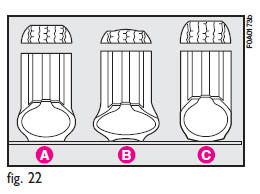Check the pressure of each tyre, including the spare, every two weeks and before long journeys.
The pressure must be checked when the tyre is rested and cold.
It is normal for the pressure to rise when you are driving. If you have to check or restore the pressure when the tyres are warm, remember that the pressure value must be 0.3 bar above the specified value.
See “Wheels” in “Technical specifications” for the correct tyre inflation pressure.
![]() Tyre pressure must be correct to ensure good road holding.
Tyre pressure must be correct to ensure good road holding.
Incorrect pressure causes abnormal tyre wear fig. 22:
A - Correct pressure: tyre wears evenly
B - Under inflated tyre: shoulder tread wear
C - Over inflated tyre: centre tread wear.

![]() If the pressure is too low the tyre overheats and this can cause it serious
damage.
If the pressure is too low the tyre overheats and this can cause it serious
damage.
Tyres must be replaced when the tread wears down to 1.6 mm. In any case, comply with the laws in the country where the vehicle is being driven.
See also:
Suspensions
...
Bodywork paint identification plate
The plate is applied on the inner side of the bonnet and it bears the following
data:
A - Paint manufacturer.
B - Colour name.
C - Fiat colour code.
D - Respray and touch up code. ...
EZ Entry Feature
The driver and front passenger seats have an EZ entry feature for rear seat passengers.
Pull forward on the release lever, located on the outboard side of the seatback,
dump the seatback forward, ...


